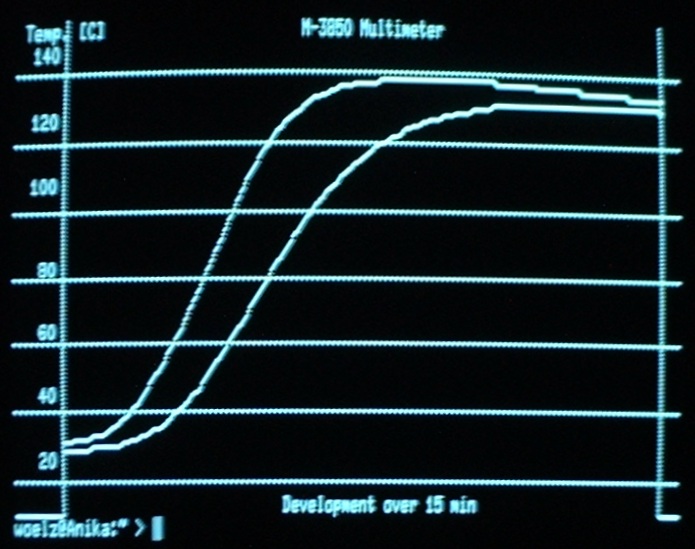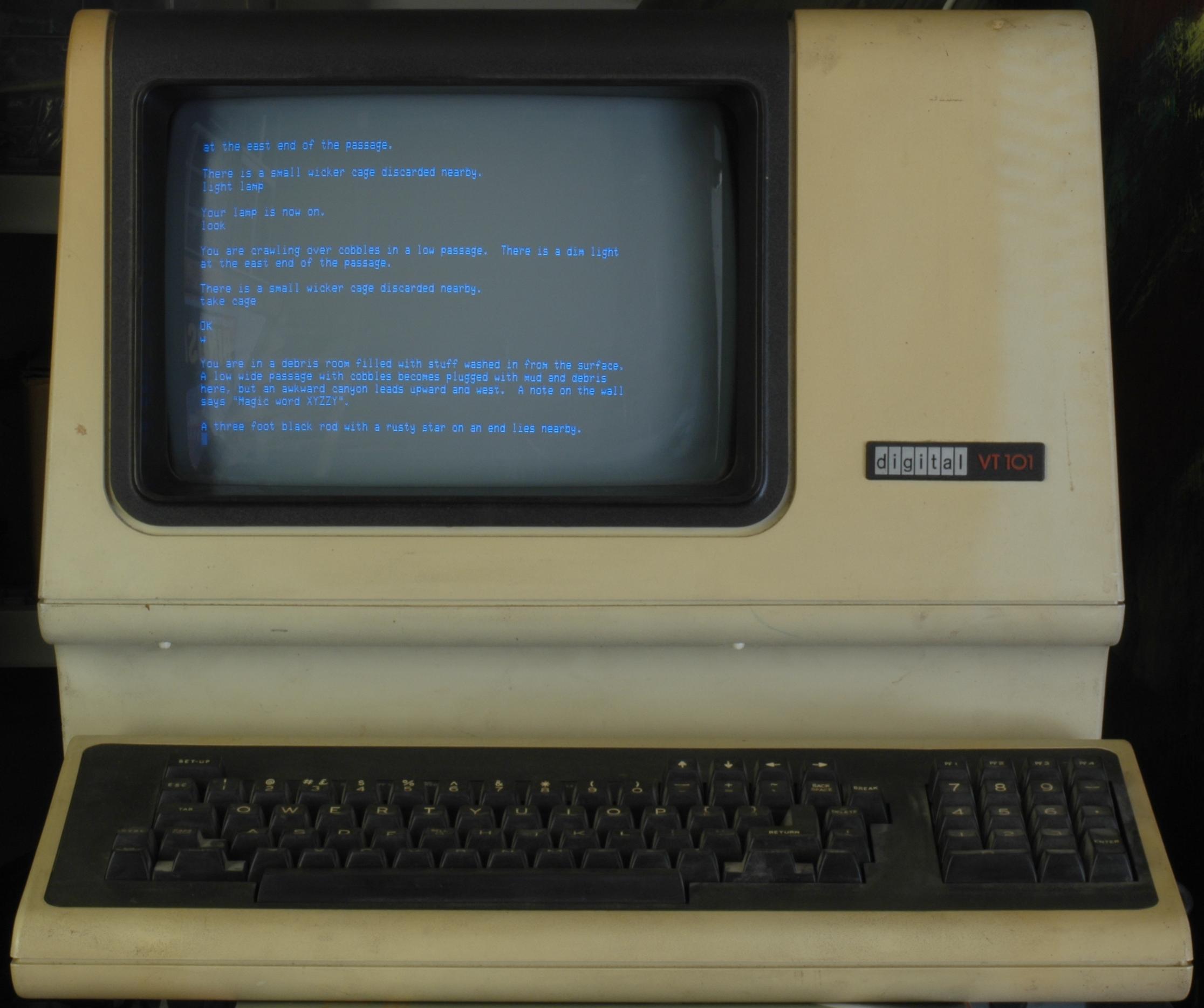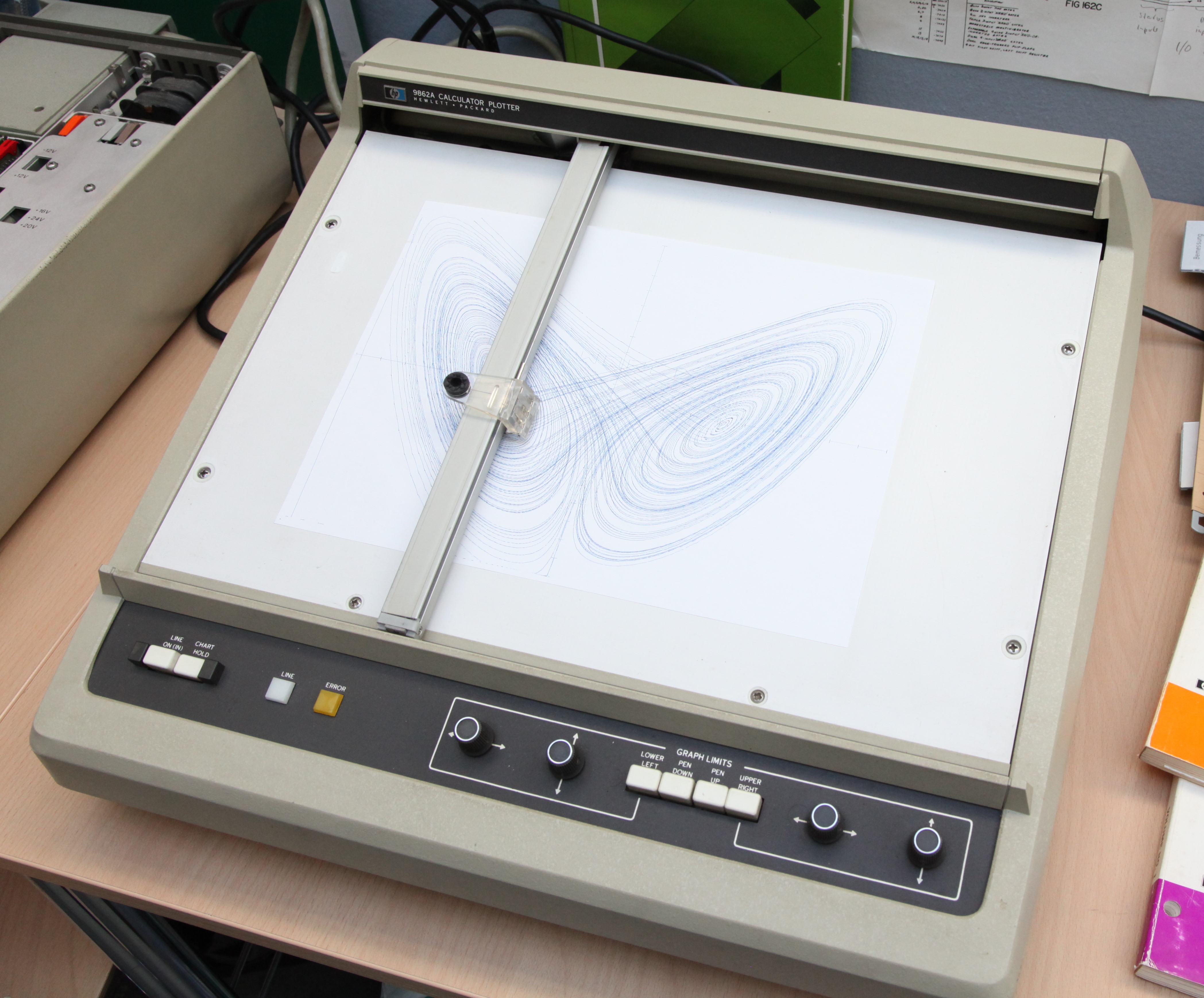|
VT55
The VT50 was a CRT-based computer terminal introduced by Digital Equipment Corporation (DEC) in July 1974. It provided a display with 12 rows and 80 columns of upper-case text, and used an expanded set of control characters and forward-only scrolling based on the earlier VT05. DEC documentation of the era refers to the terminals as the DECscope, a name that was otherwise almost never seen. The VT50 was sold only for a short period before it was replaced by the VT52 in September 1975. The VT52 provided a screen of 24 rows and 80 columns of text and supported all 95 ASCII characters as well as 32 graphics characters, bi-directional scrolling, and an expanded control character system. DEC produced a series of upgraded VT52's with additional hardware for various uses. The VT52 family was followed by the much more sophisticated VT100 in 1978. Description The VT50 supported asynchronous communication at baud rates up to 9600 bits per second and did not require any fill characters. ... [...More Info...] [...Related Items...] OR: [Wikipedia] [Google] [Baidu] |
Waveform Graphics
Waveform graphics is a simple vector graphics system introduced by Digital Equipment Corporation (DEC) on the VT55 and VT105 terminals in the mid-1970s. It was used to produce graphics output from mainframes and minicomputers. DEC used the term "waveform graphics" to refer specifically to the hardware, but it was used more generally to describe the whole system. The system was designed to use as little computer memory as possible. At any given X location it could draw two dots at given Y locations, making it suitable for producing two superimposed waveforms, line charts or histograms. Text and graphics could be mixed, and there were additional tools for drawing axes and markers. The waveform graphics system was used only for a short period of time before it was replaced by the more sophisticated ReGIS system, first introduced on the VT125 in 1981. ReGIS allowed the construction of arbitrary vectors and other shapes. Whereas DEC normally provided a backward compatible solution in ... [...More Info...] [...Related Items...] OR: [Wikipedia] [Google] [Baidu] |
VT100
The VT100 is a video terminal, introduced in August 1978 by Digital Equipment Corporation (DEC). It was one of the first terminals to support ANSI escape codes for cursor control and other tasks, and added a number of extended codes for special features like controlling the status lights on the keyboard. This led to rapid uptake of the ANSI standard, which became the de facto standard for hardware video terminals and later terminal emulators. The VT100 series, especially the VT102, was extremely successful in the market, and made DEC the leading terminal vendor at the time. The VT100 series was replaced by the VT200 series starting in 1983, which proved equally successful. Ultimately, over six million terminals in the VT series were sold, based largely on the success of the VT100. Description DEC's first video terminal was the VT05 (1970), succeeded by the VT50 (1974), and soon upgraded to the VT52 (1975). The VT52 featured a text display with 80 columns and 24 rows, bidirection ... [...More Info...] [...Related Items...] OR: [Wikipedia] [Google] [Baidu] |
Integrated Circuits
An integrated circuit or monolithic integrated circuit (also referred to as an IC, a chip, or a microchip) is a set of electronic circuits on one small flat piece (or "chip") of semiconductor material, usually silicon. Large numbers of tiny MOSFETs (metal–oxide–semiconductor field-effect transistors) integrate into a small chip. This results in circuits that are orders of magnitude smaller, faster, and less expensive than those constructed of discrete electronic components. The IC's mass production capability, reliability, and building-block approach to integrated circuit design has ensured the rapid adoption of standardized ICs in place of designs using discrete transistors. ICs are now used in virtually all electronic equipment and have revolutionized the world of electronics. Computers, mobile phones and other home appliances are now inextricable parts of the structure of modern societies, made possible by the small size and low cost of ICs such as modern compute ... [...More Info...] [...Related Items...] OR: [Wikipedia] [Google] [Baidu] |
Plotter
A plotter is a machine that produces vector graphics drawings. Plotters draw lines on paper using a pen, or in some applications, use a knife to cut a material like vinyl or leather. In the latter case, they are sometimes known as a cutting plotter. In the past, plotters were used in applications such as computer-aided design, as they were able to produce line drawings much faster and of a higher quality than contemporary conventional printers. Smaller desktop plotters were often used for business graphics. Printers with graphics capabilities took away some of the market by the early 1980s, and the introduction of laser printers in the mid-1980s largely eliminated the use of plotters from most roles. Plotters retained a niche for producing very large drawings for many years, but have now largely been replaced by wide-format conventional printers. Cutting plotters remain in use in a number of industries. Overview Digitally controlled plotters evolved from earlier fully analog ... [...More Info...] [...Related Items...] OR: [Wikipedia] [Google] [Baidu] |
Tektronix 4010
The Tektronix 4010 series was a family of text-and-graphics computer terminals based on storage-tube technology created by Tektronix. Several members of the family were introduced during the 1970s, the best known being the 11-inch 4010 and 19-inch 4014, along with the less popular 25-inch 4016. They were widely used in the computer-aided design market in the 1970s and early 1980s. The 4000 series were much less expensive than earlier graphics terminals, such as the IBM 2250, because no additional electronics were needed to maintain the display on the storage-tube screen; images drawn to the screen remained there until deliberately erased. This eliminated the need for computer memory to store the images, which was extremely expensive in the 1970s. The display series remained popular until the introduction of inexpensive graphics workstations in the 1980s. These new graphics workstations used raster displays and dedicated screen buffers that became more affordable as solid-state ... [...More Info...] [...Related Items...] OR: [Wikipedia] [Google] [Baidu] |
Histogram
A histogram is an approximate representation of the distribution of numerical data. The term was first introduced by Karl Pearson. To construct a histogram, the first step is to " bin" (or "bucket") the range of values—that is, divide the entire range of values into a series of intervals—and then count how many values fall into each interval. The bins are usually specified as consecutive, non-overlapping intervals of a variable. The bins (intervals) must be adjacent and are often (but not required to be) of equal size. If the bins are of equal size, a bar is drawn over the bin with height proportional to the frequency—the number of cases in each bin. A histogram may also be normalized to display "relative" frequencies showing the proportion of cases that fall into each of several categories, with the sum of the heights equaling 1. However, bins need not be of equal width; in that case, the erected rectangle is defined to have its ''area'' proportional to the frequency ... [...More Info...] [...Related Items...] OR: [Wikipedia] [Google] [Baidu] |
WYSIWYG
In computing, WYSIWYG ( ), an acronym for What You See Is What You Get, is a system in which editing software allows content to be edited in a form that resembles its appearance when printed or displayed as a finished product, such as a printed document, web page, or slide presentation. WYSIWYG implies a user interface that allows the user to view something very similar to the end result while the document is being created. In general, WYSIWYG implies the ability to directly manipulate the layout of a document without having to type or remember names of layout commands. History Before the adoption of WYSIWYG techniques, text appeared in editors using the system standard typeface and style with little indication of layout ( margins, spacing, etc.). Users were required to enter special non-printing ''control codes'' (now referred to as markup ''code tags'') to indicate that some text should be in boldface, italics, or a different typeface or size. In this environment there was very ... [...More Info...] [...Related Items...] OR: [Wikipedia] [Google] [Baidu] |
Convection
Convection is single or multiphase fluid flow that occurs spontaneously due to the combined effects of material property heterogeneity and body forces on a fluid, most commonly density and gravity (see buoyancy). When the cause of the convection is unspecified, convection due to the effects of thermal expansion and buoyancy can be assumed. Convection may also take place in soft solids or mixtures where particles can flow. Convective flow may be transient (such as when a multiphase mixture of oil and water separates) or steady state (see Convection cell). The convection may be due to gravitational, electromagnetic or fictitious body forces. Heat transfer by natural convection plays a role in the structure of Earth's atmosphere, its oceans, and its mantle. Discrete convective cells in the atmosphere can be identified by clouds, with stronger convection resulting in thunderstorms. Natural convection also plays a role in stellar physics. Convection is often categorised or d ... [...More Info...] [...Related Items...] OR: [Wikipedia] [Google] [Baidu] |
Font
In metal typesetting, a font is a particular size, weight and style of a typeface. Each font is a matched set of type, with a piece (a "sort") for each glyph. A typeface consists of a range of such fonts that shared an overall design. In modern usage, with the advent of computer fonts, the term "font" has come to be used as a synonym for "typeface", although a typical typeface (or "font family") consists of a number of fonts. For instance, the typeface "Bauer Bodoni" (sample shown here) includes fonts "Roman" (or "Regular"), " Bold" and ''" Italic"''; each of these exists in a variety of sizes. The term "font" is correctly applied to any one of these alone but may be seen used loosely to refer to the whole typeface. When used in computers, each style is in a separate digital "font file". In both traditional typesetting and modern usage, the word "font" refers to the delivery mechanism of the typeface. In traditional typesetting, the font would be made from metal or wood type: ... [...More Info...] [...Related Items...] OR: [Wikipedia] [Google] [Baidu] |
Character Generator
A character generator, often abbreviated as CG, is a device or software that produces static or animated text (such as news crawls and credits rolls) for keying into a video stream. Modern character generators are computer-based, and they can generate graphics as well as text. History Monoscopes were used as character generators for text mode video rendering in computer displays for a short time in the 1960s. The CBS Laboratories Vidiac, and the A. B. Dick 990 System, were among the earliest character generators for broadcast television. CBS Laboratories later developed the more advanced Vidifont system in preparation for the 1968 US presidential elections, where a rapid method of all-electronic character generation was required so that news outlets could identify unexpected interviewees on the spot. A similar generator using analogue electronics, Anchor, was developed by the BBC in 1970 and used in the general election later that year. Usage In the television business in N ... [...More Info...] [...Related Items...] OR: [Wikipedia] [Google] [Baidu] |
Toilet Tissue
Toilet paper (sometimes called toilet tissue or bathroom tissue) is a tissue paper product primarily used to clean the human anus, anus and surrounding anal region of feces after defecation, and to clean the perineum, perineal area and external genitalia of urine after urination or other body fluid, bodily fluid releases. It also acts as a layer of protection for the hands during these processes. It is usually supplied as a long strip of perforated paper wrapped around a paperboard core for Toilet paper holder, storage in a dispenser near a toilet. The bundle is known as a toilet roll, or loo roll or bog roll in British English, Britain. There are other uses for toilet paper, as it is a readily available household product. It can be used like facial tissue for blowing the nose or wiping the eyes. Some women may use the paper to absorb the bloody discharge that comes out of the vagina during menstruation. It can be used to wipe off sweat or absorb it. Toilet paper can be used ... [...More Info...] [...Related Items...] OR: [Wikipedia] [Google] [Baidu] |
Electrolytic
An electrolyte is a medium containing ions that is electrically conducting through the movement of those ions, but not conducting electrons. This includes most soluble salts, acids, and bases dissolved in a polar solvent, such as water. Upon dissolving, the substance separates into cations and anions, which disperse uniformly throughout the solvent. Solid-state electrolytes also exist. In medicine and sometimes in chemistry, the term electrolyte refers to the substance that is dissolved. Electrically, such a solution is neutral. If an electric potential is applied to such a solution, the cations of the solution are drawn to the electrode that has an abundance of electrons, while the anions are drawn to the electrode that has a deficit of electrons. The movement of anions and cations in opposite directions within the solution amounts to a current. Some gases, such as hydrogen chloride (HCl), under conditions of high temperature or low pressure can also function as electrolytes. El ... [...More Info...] [...Related Items...] OR: [Wikipedia] [Google] [Baidu] |


.jpg)




.jpg)
